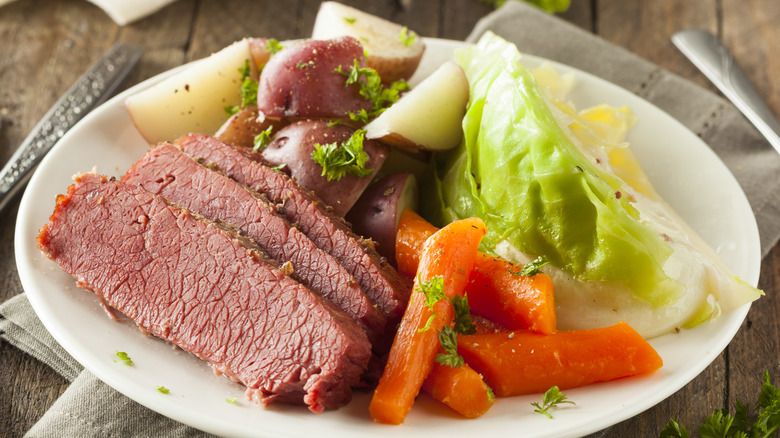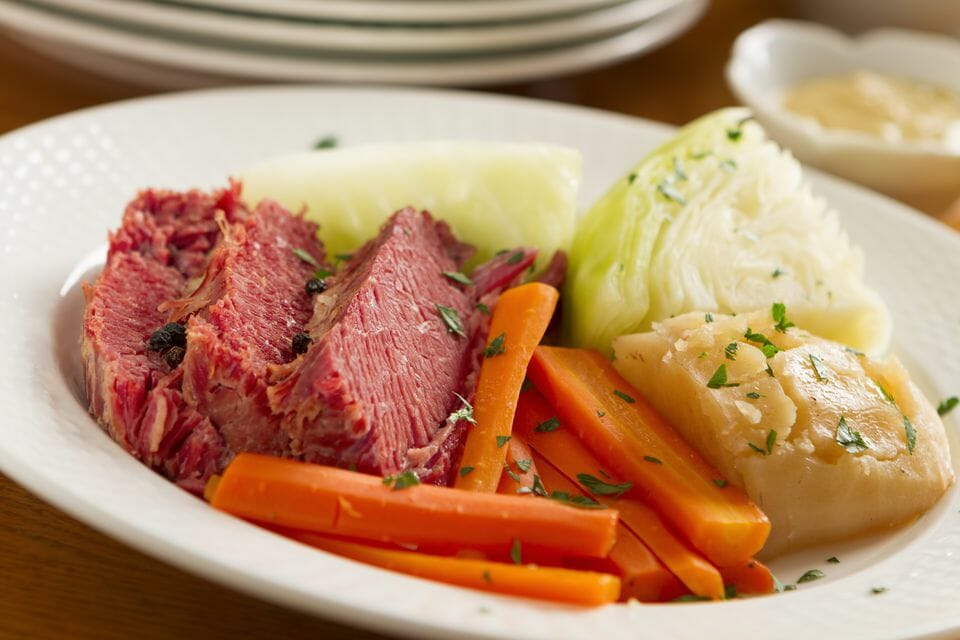St Patrick’s Day is right around the corner, which means it’s almost time to break out the corned beef and cabbage for a traditional Irish-American feast! But have you ever wondered why corned beef and cabbage became so closely tied to this holiday in the first place? As it turns out, the tradition has more to do with Irish-American culture and history than with authentic Irish cuisine.
A Brief History of Corned Beef
Corned beef gets its name from the large “corns” of salt that were historically used to cure the meat. The process of curing and brining meats to preserve them was brought to Ireland by the ancient Celts. High quality cuts of the meat were packed with salt and exported across Britain and Europe. Lesser quality cuts would be reserved for local Irish consumption. The poor would eat salted pork and bacon alongside vegetables like cabbage and potatoes.
By the 19th century, advancements in food preservation and refrigeration made salt-cured meats less crucial for preservation. Around this time, Irish immigrants were arriving in America in large numbers, settling in cities like New York, Boston, and Chicago. There, they found brisket, a Jewish cut of kosher beef, to be an ample and more affordable substitute for Irish bacon. Jewish butchers at the time prepared the brisket using the same curing method as Irish corned beef, packing the meat in a brine with cloves, bay leaves, peppercorns, mustard seeds and other spices. The Irish adopted the Jewish corned beef, as it was reminiscent of the salt-cured meats from their homeland.
Why Corned Beef and Cabbage for St. Patrick’s Day?
In Ireland, St. Patrick’s Day was traditionally observed as a religious feast day by attending church services and honoring the country’s patron saint. Irish Americans transformed the holiday into a largely secular celebration of all things Irish. Corned beef and cabbage suppers quickly became a tradition because of corned beef’s association with Irish culture and history. The affordable brisket could feed a large crowd of revelers, and cabbage had long been a staple of the Irish diet.
Despite the holiday’s roots, corned beef and cabbage is more American than authentically Irish. While bacon and lamb are frequently enjoyed in Ireland, corned beef has more ties to Jewish culture But the hearty, salted meat took hold in Irish enclaves, where it was incorporated into the celebrations. Over time, corned beef and cabbage on St. Patrick’s Day became an enduring Irish-American tradition
Corned Beef Cooking Tips
-
Choose the right cut. Look for a well-marbled brisket when selecting corned beef. The fat content helps keep the meat moist during cooking. Opt for a first cut or point cut brisket over the leaner, second cut.
-
Give it a soak. Rinse off the brine and soak the corned beef in water for 4-8 hours before cooking. This reduces excess saltiness. Swap out the water occasionally.
-
Slow and low. Cook the corned beef low and slow, at 200°F – 250°F for 3-4 hours in a Dutch oven with a lid. Add vegetables like onions, carrots and celery during the last 45 minutes.
-
Steam that cabbage. For perfect cabbage wedges, core and cut the cabbage into quarters or sixths. Steam until just tender, about 5-7 minutes depending on size. Avoid overcooking.
-
Rest before slicing. Allow the cooked corned beef to rest 15-20 minutes before slicing across the grain. This allows the juices to reabsorb for more tender and moist meat.
-
Flavor the leftovers. Transform leftover corned beef into tasty hash for breakfast, pile it onto sandwiches and pizza, or incorporate it into casseroles, soups and salads. It will keep refrigerated for 4-5 days.
Serving Suggestions Beyond Cabbage
While cabbage may be the most traditional pairing, corned beef also matches well with other vegetables like:
-
Potatoes – boiled, mashed, hash browns, fries
-
Carrots – glazed, roasted, in stew
-
Parsnips – mashed, roasted
-
Kale – braised, sautéed
-
Brussels sprouts – roasted, shaved salad
-
Asparagus – grilled or roasted
-
Beets – roasted, shaved salad
-
Green beans – steamed, sautéed
Trendy Ways to Enjoy Corned Beef Year-Round
Thanks to its salty, savory flavor, corned beef isn’t just reserved for St. Patrick’s Day anymore. Creative chefs have come up with delicious ways to enjoy it beyond just boiled dinners.
-
Corned beef hash – A breakfast diner staple, made with potatoes and onions
-
Reubens and Rachel sandwiches – Piled high on rye bread with sauerkraut, Swiss cheese and Russian dressing
-
Corned beef pizza – As a topping instead of pepperoni or sausage
-
Corned beef tacos or burritos – Substitute for ground beef
-
Corned beef nachos – Chips, cheese, pico de gallo and shredded corned beef
-
Corned beef dip – Shredded with melty cheese, onions and spices for dipping bread or veggies
-
Corned beef burgers – Mix shredded corned beef into burger patties
-
Corned beef Caesar salad – As a smoky substitute for bacon bits
Key Takeaways
-
Corned beef and cabbage became tied to St. Patrick’s Day among Irish Americans in the early 20th century.
-
It was adopted by Irish immigrants as a stand-in for Irish bacon. The beef was brined and spiced similarly to Irish corned beef by Jewish butchers.
-
While not traditionally Irish, it came to symbolize Irish-American identity and became central to holiday celebrations.
-
Cook it low and slow, slicing across the grain when tender. Cabbage is traditional but potatoes, carrots and other veggies also pair well.
-
Creative recipes allow you to enjoy corned beef beyond just holiday boiled suppers.
So when you celebrate St. Patrick’s Day this year with a piping hot platter of corned beef and cabbage, appreciate the many cultural influences that brought this hearty dish to your table!

The Rise of Corned Beef

In Ireland, beef was a meat reserved for the wealthy, and most of it was exported to England. The Great Famine resulting from potato blight caused the mass migration of the Irish to the shores of the new world. In this new American home, corned beef was readily available to the Irish immigrants. Long deprived of the beef that was salted by Irish hands, the migrants gladly purchased the food they finally could afford. Although the kosher cut was different from the beef their great grandparents enjoyed, the meal became a comfort for the newly-minted Americans. This article in Smithsonian Magazine covers the entire history of the meat that has become synonymous with the day.
The Feast of Saint Patrick

One could argue that the modern way of celebrating of St. Patrick’s Day is purely Irish-American. As covered in last year’s post, historically, the holiday was religious and reflective, celebrated by sharing cultural lore and honoring St. Patrick. However, there are many similarities between the historic celebrations of honoring the saint, and our traditions today. Observing the old ways in remembrance of their homeland helped unite the scattered Irish migrants. So, as they did in Ireland, Irish-Americans carried over the tradition of wearing shamrocks and enjoying Irish libations, such as Guinness and Irish whiskey. And today as in days of old, we enjoy soda bread and cabbage. Read our post from last year to get great recipes for both, as well as the full meal and leftovers.

Now that you know the reason we eat corned beef and celebrate the day, we get to the good part: cooking the meal! Butcher Boy Market makes grey corned beef and corned ribs, sells red corned beef, and serves grey corned beef dinners in our kitchen. Feel like making your meal at home? The key is to cook the beef slowly to create a tender, flavorful meal. Consult this guide from The Spruce on cooking corned beef three delicious ways: boiled, baked, or submerged in a slow cooker. Each way has its benefits. If you enjoy a crispy crust, then baking is for you! If you plan on spending the day out at a parade, slow cooker is the way to go. If you’re truly going traditional, then broiling will be the ticket to your perfect St. Paddy’s Day meal.
Why do we eat corned beef on St. Patrick’s Day?
FAQ
Why do people eat corned beef and cabbage on New Year’s Day?
Many with Irish heritage prepare Corned beef and cabbage dinner on New Year’s day. It is associated with the fortune you should hope for in the coming year. Beef or pork is the meat of choice because unlike chickens these animals do not scratch in the dirt for their food.
Why are Reubens associated with St. Patrick’s Day?
In the U.S., Irish immigrants often ended up being neighbors to Jewish delis, where corned beef was familiar and affordable. Often associated with Irish food gatherings, corned beef and cabbage has been upgraded into the iconic Reuben, as the pub crawl culture of the holiday has brought about more portable foods.
What holiday is associated with corned beef?
For most of us in the U.S., corned beef and cabbage is synonymous with St. Patrick’s Day. But its association with the holiday isn’t an Irish tradition. It is a uniquely American tradition, a blending of both history and opportunity.
Why do you eat corned beef?
Its an American Irish tradition. IIRC, when the Irish came over to the US, they were poor and struggling and used Corned Beef, an inexpensive cut of meat from Jewish delis instead of pork, which was a luxury item at the time. We eat it along with the cheapest vegetables (carrots, potatoes, cabbage).
Why do Americans eat corned beef & cabbage on St Patrick’s Day?
The tradition of eating corned beef and cabbage on St. Patrick’s Day in America has its roots in the experiences of Irish immigrants in the late 19th and early 20th centuries. While it may not be a traditional Irish dish, it has become an important part of Irish-American culture and is enjoyed by many people on this holiday.
Can you eat corned beef on St Patrick’s Day?
So, this St. Patrick’s Day, whether you choose to eat corned beef or bacon with your cabbage, take a moment to appreciate the history and tradition behind these iconic dishes. Corned beef is traditionally made with brisket, which is a cut of beef from the breast or lower chest of the cow.
Why is corned beef important to St Patrick’s Day?
The connection of corned beef to St. Patrick’s Day is not just about food; it symbolizes a collective memory and identity that transcends its geographic origins. It embodies how cultures influence one another, creating hybrid traditions that continue to be celebrated.
Why do Irish people eat corned beef?
Their best option for a lower-cost meat was, you guessed it: corned beef. What was once a luxury item became a food that was now inexpensive and readily available. So it was the Irish-American consumption of corned beef that initiated its association with Ireland and the holiday of St. Patrick’s Day.
Why do Americans eat corned beef?
Corned beef emerged as an economical alternative to traditional Irish meats, gaining popularity among the immigrant community, and inevitably becoming a symbol of St. Patrick’s Day celebrations in America. Moreover, the marketing of corned beef as a festive dish helped to cement its status in American culture.
How did St Patrick’s day become so intrinsically tied to corned beef?
So, how did the most famed Irish holiday become so intrinsically tied to corned beef? According to Irish Central, the link between corned beef and St. Patrick’s Day can be traced back to Irish-American immigrants in the 19th and 20th centuries.
